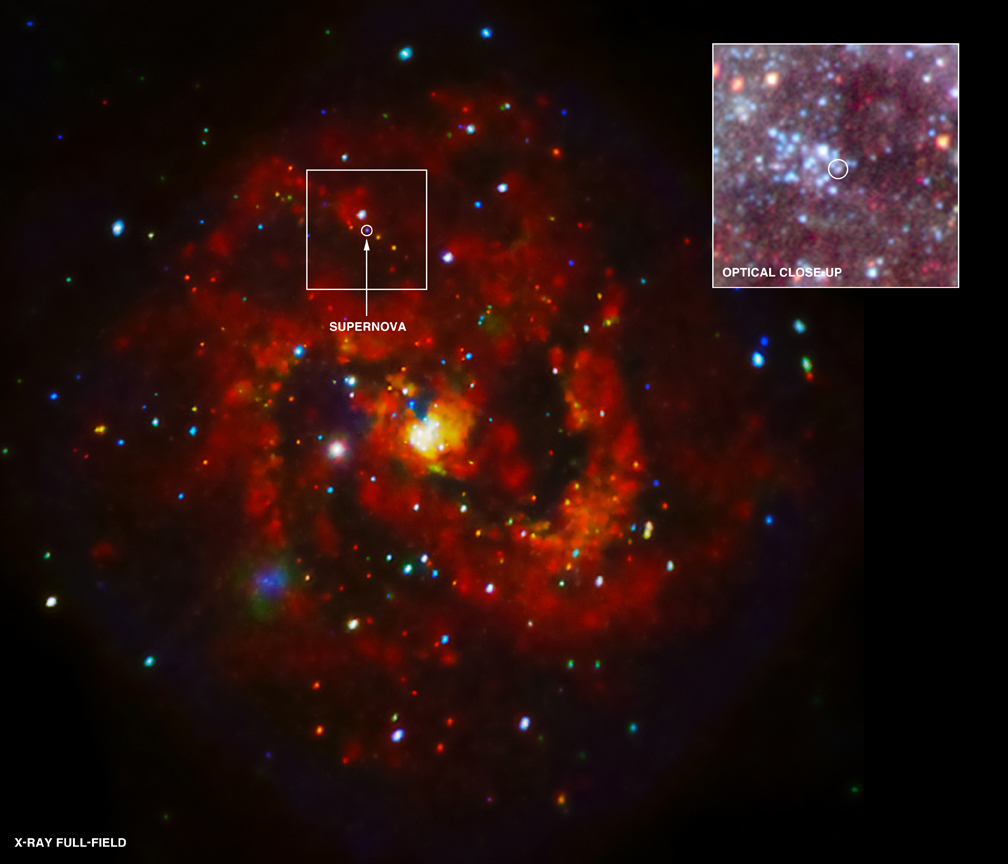Spiral Galaxy Photo Sheds New Light on Recent Star Explosion

A new, extremely deep photo of the site of a supernova explosion that was observed in 1957 has revealed X-rays emanating from the source.
The photo, taken by NASA's Chandra X-Ray space telescope, is the first to spot X-ray light coming from the remains of the dead star that sparked the explosion, and indicates that the supernova likely transformed the star into a pulsar. Pulsars are super-dense, fast-rotating objects that have been compressed so tightly they are composed only of neutrons.
The supernova, called SN 1957D (because it was the fourth supernova discovered in 1957), lies in the M83 galaxy, which is about 15 million light-years from Earth. Previous observations of the spiral galaxy have revealed only radio and optical light coming from the supernova site. Observation of the galaxy by Chandra from 2000 to 2001 collected light over 14 hours but did not detect any X-rays coming from the supernova remnant.
A more recent Chandra exposure of 219 hours and 49 minutes — about eight and a half days — collected enough light to see X-ray radiation from the spot. The photo, taken in 2010 and 2011, was released by NASA today (July 30).
In the picture, red, green, and blue light represents low, medium, and high-energy X-rays, respectively. The site of SN 1957D is located on the inner edge of the spiral arm just above the galaxy's center, marked with a box in the photo.
Analysis of the energy levels of the X-rays coming from SN 1957D suggests that the star that died in the supernova is now a pulsar, and that furthermore the pulsar has created a cocoon of fast-moving charged particles around it called a pulsar wind nebula.
"If this interpretation is confirmed, the pulsar in SN 1957D is observed at an age of 55 years, one of the youngest pulsars ever seen," scientists wrote in a statement.
Get the Space.com Newsletter
Breaking space news, the latest updates on rocket launches, skywatching events and more!
The new findings will be published in an upcoming issue of The Astrophysical Journal.
Follow SPACE.com on Twitter @Spacedotcom, or on Facebook & Google+.
Join our Space Forums to keep talking space on the latest missions, night sky and more! And if you have a news tip, correction or comment, let us know at: community@space.com.

Space.com is the premier source of space exploration, innovation and astronomy news, chronicling (and celebrating) humanity's ongoing expansion across the final frontier. Originally founded in 1999, Space.com is, and always has been, the passion of writers and editors who are space fans and also trained journalists. Our current news team consists of Editor-in-Chief Tariq Malik; Editor Hanneke Weitering, Senior Space Writer Mike Wall; Senior Writer Meghan Bartels; Senior Writer Chelsea Gohd, Senior Writer Tereza Pultarova and Staff Writer Alexander Cox, focusing on e-commerce. Senior Producer Steve Spaleta oversees our space videos, with Diana Whitcroft as our Social Media Editor.












